Fauré Le Page
Fauré Le Page (French pronunciation: [fɔ.ʁe lə‿paʒ]) is a French firearms manufacturer (arquebusier and fourbisseur) established in Paris in 1717. Founded by Louis Pigny, the company remained in the same family until 1913. Throughout its history, the manufacturer was successively called Pigny, Le Page, Le Page Moutier and finally, Fauré Le Page in 1865. The brand's unique and luxurious craftsmanship quickly gathered a royal and imperial clientele. In addition, the manufacturer’s commitment to the French Revolution together with recognition from authors also enhanced the prestige of the brand. The company which had long made holsters and gun bags now also makes organizers and handbags.
History
Louis Pigny
The firearms manufacturer Louis Pigny opened shop in 1717 at Rue Baillif (today Rue des Bons-Enfants) in the 1st arrondissement of Paris. He received two royal warrants from King Louis XV in 1735 and 1756. He passed on his business to Pierre Le Page (or Lepage) who married his niece.[1]
Pierre Le Page (1709–83)
Le Page's time (1743–79)[2] was particularly notable since it secured the House of Orléans as one of the company's distinguished clients. He was born in Normandy and he arrived in Paris in 1723. He started training the following year at the master gunsmith, Mazillier. The same year, he started to work for Louis Pigny.
After Pigny's death in 1743, Le Page, who was already the master of firearms artillery and explosives at Pigny, inherited the firearms business. He also changed the firearms manufacturer's name from Pigny to Le Page (or Lepage) and moved, in 1759, to number 13, Rue de Richelieu.
He acquired an excellent reputation among his aristocratic clientele and became the first firearms supplier of the Maréchal Maurice de Saxe and then, finally, the House of Orléans. In 1767, Pierre Le Page delivers a gun to King Louis XV. As he is without a successor, he left the company to his nephew, Jean Le Page.
Jean Le Page (1746–1834)
Jean Le Page time (1779–1822)[2] saw further expansion of the firearms manufacturing business Le Page. Aside from the House of Orleans, the company also included King Louis XVI, Napoleon Bonaparte, and King Louis XVIII as its clients. He was also born in Normandy like his uncle. He came to Paris with the initial goal of becoming a chemist. He ended up starting his training at Pierre Le Page in 1764. His training lasted four years. By 1779, he succeeded his uncle who gave him his letter of mastery in 1780.
Jean Le Page led the family business and proceeded on enhancing the prestige of the brand. The factory, famous for its pistols, its guns, its luxury white arms, and its page swords during the First French Empire was already the chief to the weapons produced by Nicolas-Noël Boutet in Versailles.[3] The brand made many technical innovations and these is demonstrated in the numerous warrants and patents it obtained such as the warrant for a mise à feu platinum using over-oxygenated powder in 1810, a warrant of invention for a water-resistant gun in 1817, and a warrant for a silex platinum "pouvant être mise à feu à volonté à poudre fulminante" in 1821. These advances were clearly pertaining to substance because in 1809, Le Page introduced "une platine à percussion to society in order to encourage the National Industry in front of which he gave a highly successful demonstration by shooting three hundred times without missing once".[4]
As purveyor of arms to kings he brought in an extremely prestigious clientele and this include Armand Augustin Louis de Caulaincourt, Duke of Vincence, baron Gaspard Gourgaud, the Marshall Emmanuel de Grouchy, General Charles de Flahaut, the Marchioness Catherine-Dominique de Pérignon, the Marshall André Masséna, Duke of Rivoli, Baron Daru, General Carlo Andrea Pozzo di Borgo, andf the perfumier Jean-François Houbigant, among others.
Many pieces bear testimony to this sumptuous period, Jean Le Page "is without doubt the imperial gunsmith most quoted both in literary texts and in arms notices exhibited in museums". A shooting gun for Louis Philippe II, Duke of Orléans (future Philippe Égalité) is presented to the Museum of the Porte de Hal in Brussels. First Consul Bonaparte's sword is exhibited at the Château de Malmaison. The Musée de la Chasse et de la Nature in Paris also has several beautiful Le Page pieces including two of Emperor Napoleon I's shooting guns belonging to a series made in 1775 for King Louis XVI and modified around 1806 ; a silex gun that had belonged to King Louis XVIII[5] and a nécessaire box containing a pair of silex guns for children, a gift from King Charles X to the Duke of Bordeaux, future Count of Chambord.[6]
Le Page’s store was at number 13, rue de Richelieu (which became number 950 rue de la Loi during the period of the Revolution), near the Palais Royal which strategically placed it in the midst of the action in 1789 and in 1830. It appears that the family played an active role in preparing for the Take of the Bastille and in the Trois Glorieuses by distributing firearms to the people.
Four out of his six children pursued a career in armoury. The eldest daughter Justine married Louis Perrin,[7] arquebusier in Poitiers from 1813 to 1830 then in Paris, with bronze medals at the French Industrial Exposition of 1834, the Exposition of 1839 and the Exposition of 1844. He used Perrin Le Page as his signature.
André Jean Thomas, the second child, becomes arquebusier and settles down elsewhere at number 24 rue de la Monnaie around 1823. He uses Le Page Fils as his signature.
Jean André Prosper Henri Le Page, the fourth child succeeds his father in 1822. Eléonore Méliade marries the officer Louis Didier Fauré.
Jean André Prosper Henri Le Page (1792 – Vichy 1854)
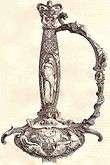
Arquebusier and fourbisseur in Paris (1822–42)[2] of King Louis XVIII, King Charles X et de King Louis Philippe and of the House of Orleans.
He succeeds his father in 1822 and in 1835 is nominated Arquebusier Ordinaire of the King, of the Duke of Orleans and of the Duke of Nemours. He owns a gunnery on the Champs-Élysées, rue des Gourdes which became rue Marbeuf.
While he was director, the international reputation of Le Page increased. He participated in the Paris Exhibitions of 1823, 1827, 1834, and received a Silver Medal at the 1839 Exhibition. The shop remained at number 13 rue de Richelieu.
The majority of the wares included guns and revolvers, often luxuriously crafted, but there was also the percussion gun with a snap clasp whose barrel would swivel to the side when one loaded its breechblock. When this gun was introduced in 1838 to a French military commission, the government had six hundred of them manufactured in the royal factory of Saint-Étienne to be used by the Lancers Regiment.
Jean Le Page's participation as an official expert in the trial of Giuseppe Fieschi and in the trial of the landing of Louis-Napoléon Bonaparte in Boulogne demonstrated Le Page’s hard-earned reputation.
In 1842, he relinquished the direction of his company to his son-in-law.
He was the author of a text that establishes the genealogy of the Le Page family which is kept in the National Archives of the French National Library in the Fonds Bro de Comères[8]
Gilles Michel Louis Moutier-Le Page (Bayeux 1810 – Montfermeil 1887)
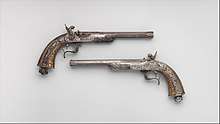
Arquebusier et fourbisseur in Paris (1842–1865).[9] Gilles Michel Louis Moutier marries Louis Didier Fauré's daughter. He takes Henri Le Page’s succession in 1842 and signs Le Page-Moutier.
Silver medal at the Paris Expos of 1844 and 1849 and 1st Class medal at the 1855 Expo. He takes part in the London Expos in 1851 where he receives another medal– and in 1862.[10] In 1865, he was joined in business by Henri Le Page's nephew, Emile Henry Fauré.
Emile Henry Fauré Le Page (Paris 1840 – Paris 1929)
Arquebusier et fourbisseur in Paris (1865–1913),[11] Warranted supplier to the Russian Imperial Court.
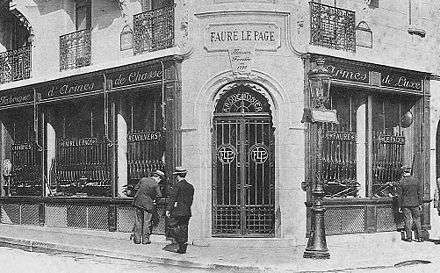
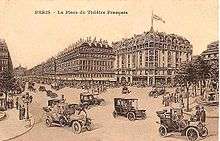
Emile was Henri Le Page's nephew, and Louis Didier Fauré and d’Eléonore Méliade’s son. He became partner with Gilles Louis Michel Moutier in 1865 and becomes sole owner in 1868.
He developed his international clientele and became the warranted supplier to the Russian Imperial Court. Taking part in each of the Universal Expos he accumulated honours in Paris in 1865 (First Class Medal), in 1867 (Silver Medal), in 1878 (Gold Medal), in 1889 (Grand Prix), and in Vienna in 1873 (Medal of Progress[11])
He was ordained Chevalier de la Légion d'Honneur in 1878 and then Officer of the Légion d’Honneur in 1894.
The store opened at number 8, rue de Richelieu (at the corner with the rue de Montpensier which gives onto the Place du Théâtre Français), at the foot of the Royal Palace Hotel which opened its doors in 1909.
In 1913, the armourer Dumond took over Fauré Le Page but kept the brand name and formed a company in 1925.[12]
Emile Henry Fauré Le Page died in 1929 and was buried at the Père Lachaise Cemetery.
A revolutionary commitment
Le Page's staying power is undoubtedly surprising but it is the company's capacity to become the official supplier of each new government which is particularly impressive. The store's location, near the Palais-Royal puts the arquebusier at the heart of the political events during the eighteenth and nineteenth centuries. One imagines how strategically important warehouses full of firearms were during popular uprisings. It appears though that the Le Page family accompanied the revolutionary movement and from the beginning placed itself on the side of the protesters in 1789 and in 1830.
Many texts bear testimony to their patriotic commitment:
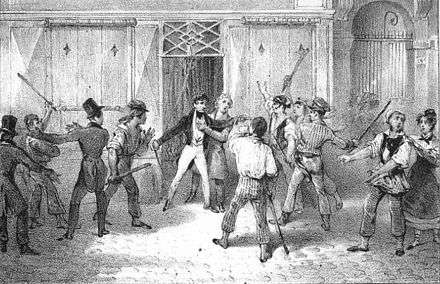
"-M. Lepage, arquebusier, on Tuesday 27th July, deemed it his duty to oppose himself to the pillaging of the antique and precious firearms in his shops; he wanted to undertake himself, along with his employees, a regular distribution of anything of use for the personal defence of his compatriots. During these three days Mr. Lepage incessantly distributed firearms and munitions to everybody; on the morning of the 27th, he provided a hundred and twenty pounds of gunpowder. Since Tuesday, there has a continuous flow of people in his shop; firearms were distributed at all hours, his eighty-five year old father helped him throughout. Patriotism is clearly hereditary in the Lepage family. During the first revolution, Mr. Lepage, arquebusier, gave up his stores three times to the defenders of freedom; today Mr. Lepage his son, has kept only his national gun and at the moment, along with all his triumphant fellow-citizens, he is under arms in his municipality."[13]
"-While the Swiss Guard lying in ambush in the houses of rue Saint-Honoré where organizing the rue de Richelieu, one could see the ladies from Lepage go out into the street to distribute lead and other metals to the brave citizens who were fighting uncovered amidst the bullets."[14]
"There are however two facts one must take note of, because they are clues about popular sentiment. We know that on the 27th and 28th, all the signs of the patented arms dealers were either vandalized or broken. The gunsmith Le Page’s sign, rue de Richelieu, read: Arquebusier of His Royal Highness Monseigneur the Duke of Orleans. The people had crossed out in black His Royal Highness and had neatly respected the name of the Duke of Orleans".[15]
References
- Quoted by Jean-Jacques Buigné, Op. cit., p. 322.
- Quoted by Jean-Jacques Buigné, Op. cit., p. 255.
- Cadiou p. 59.
- Cité par Merill Lindsay, Op. cit., p. 46.
- La Gazette de l'Hôtel Drouot, N°44, 12 décembre 2003
- Le Figaro Magazine, "Biennales Internationale des Antiquaires au Carrousel du Louvre: Des siècles de splendeur et de Faste", p89, 12 septembre 1998
- Cité par Jean-Jacques Buigné, Op. cit., p. 315.
- Jean Le Page's daughter, Claire Le Page married General Louis Bro's son, Olivier Bro de Comères.
- Quoted by Jean-Jacques Buigné, Op. cit., p. 256.
- Les revolvers Lepage Moutier, Gazette des Armes, numéro 443, juin 2012, page 14-15.
- Quoted by Jean-Jacques Buigné, Op. cit., p. 167.
- Cité par Jean-Jacques Buigné, Op. cit., p. 156.
- Cité par Casimir Delavigne, Op. cit., p. 122 & 123.
- Cité dans Relation historique des journées mémorables des 27,28, 29 Juillet 1830 en l'honneur des Parisiens, p. 104.
- Cité par Victor de Nouvion, Op. cit., p. 224
Bibliography
- Le "Qui est qui" de l'arme en France de 1350 à 1970 tome 1 de Jean-Jacques Buigné - Éditions du Portail. 2001. ISBN 2-86551-044-1.
- Grands noms de l'armurerie de Yves Louis Cadiou - Éditions du Portail - Le Hussard. 1999. ISBN 2-86551-043-3.
- L'arme de chasse » de Olivier Achard & Christian Tavard - Editions Proxima. 2000 ISBN 2-84550-009-2.
- Histoire des Armes à feu du XV au XX siècle » de Merrill Lyndsay - Walker & Co. NY. 1972.
- Le Cabinet de Diane au Musée de la Chasse et de la Nature de Claude d'Anthenaise - Citadelles & Mazenod. 2007. ISBN 978-2-85088-253-1.
- Evénemens de Paris des 26,27,28 et 29 juillet 1830 et jours suivans par plusieurs témoins occulaires Casimir Delavigne - Chez J.P. Voglet Imprimeur-Libraire à Bruxelles. 1830.
- Relation historique des journées mémorables des 27,28, 29 juillet 1830 en l'honneur des Parisiens - H. Langlois Fils Éditeur- Paris. 1830.
- Histoire du règne de Louis-Philippe Ier. Tome 1 Victor de Nouvion - ChezDidier & Cie-Libraires Éditeurs à Paris. 1858.